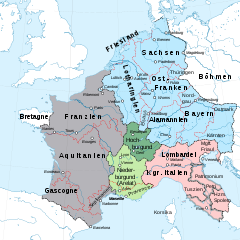 Division of the Frankish Empire after the Treaty of Ribemont in 880.
Italy
East Francia
West Francia
Upper Burgundy
Lower Burgundy Division of the Frankish Empire after the Treaty of Ribemont in 880.
Italy
East Francia
West Francia
Upper Burgundy
Lower Burgundy
| |
| Date | 880 |
|---|---|
| Location | Ribemont |
| Participants | Louis the Younger, Louis III of France, Carloman II |
| Outcome | All of Lotharingia given to East Francia |
The Treaty of Ribemont in 880 was the last treaty on the partitions of the Frankish Empire. It was signed by the German king Louis the Younger and the kings of West Francia, Louis III and Carloman.
After the death of Charles the Bald, Louis the Younger secured the friendship of Charles' successor Louis the Stammerer with the Treaty of Fourons in November 878. The two cousins promised to accept the successions of their respective sons. The treaty was put to the test when Louis the Stammerer died in April 879. A western delegation led by Gauzlin, bishop of Paris and later protector of the city during the Viking raids, invited Louis the Younger to take control of West Francia. Because his wife Luitgard also supported this idea, Louis the Younger invaded West Francia. He reached as far as Verdun, but he retreated after his nephews, the kings Louis III of France and Carloman of France, gave up their share of Lotharingia to him.
Meanwhile, Boso of Provence, a noble of Carolingian descent, proclaimed himself king of Provence (see: Lower Burgundy). Moreover, the Vikings resumed their attacks. To deal with these threats, the Carolingian kings decided to put aside their differences so as to deal with the threats together. They met at Ribemont, in present-day Aisne. In return for Louis the Younger's neutrality, the kings of France acknowledged Louis' possession of the whole of Lotharingia. This included the western part of it, which West Francia had previously acquired in the Treaty of Meerssen. The two brothers were thereafter free to deal with Boso.
The border between France and the Holy Roman Empire remained largely the same until the Late Middle Ages.
Earlier Frankish partitions were:
- Treaty of Verdun (843)
- Treaty of Prüm (855)
- Treaty of Meerssen (870)
References
- Gillespie, Alexander (2013-10-16). The Causes of War: Volume 1: 3000 BCE to 1000 CE. Bloomsbury Publishing. p. 179. ISBN 978-1-78225-208-5.
- History and politics in late Carolingian and Ottonian Europe: The Chronicle of Regino of Prüm and Adalbert of Magdeburg. Manchester University Press. 2013-01-01. p. 181. ISBN 978-1-5261-1280-4.
- Martel, Gordon (2018-04-30). The Encyclopedia of Diplomacy, 4 Volume Set. John Wiley & Sons. p. 286. ISBN 978-1-118-88791-2.
Sources
- Goldberg, Eric J. (2006). Struggle for Empire: Kingship and Conflict under Louis the German, 817-876. Ithaca, NY: Cornell University Press.
- McKitterick, Rosamond (1983). The Frankish Kingdoms Under the Carolingians, 751-987. Harlow: Longman.
- McKitterick, Rosamond (2008). Charlemagne: The Formation of a European Identity. Cambridge: Cambridge University Press.
- Reuter, Timothy (2013) . Germany in the Early Middle Ages c. 800–1056. London and New York: Routledge.
- Reuter, Timothy (2006). Medieval Polities and Modern Mentalities. Cambridge: Cambridge University Press.
- West, Charles (2023). The Fall of a Carolingian Kingdom: Lotharingia, 855–869. Toronto: University of Toronto Press.